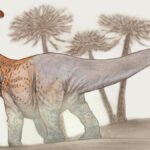Long-necked dinosaurs, known as sauropods, are some of the most iconic and awe-inspiring creatures in the prehistoric world. With their towering necks, massive bodies, and herbivorous diets, sauropods have captured the imagination of paleontologists and dinosaur enthusiasts alike. Among these giants, one question stands out: Which long-necked dinosaur was the largest?
The title of the largest long-necked dinosaur is a subject of intense debate, as new discoveries continue to shed light on these ancient giants. However, there are a few contenders that consistently rise to the top. Among the most notable are Argentinosaurus, Brachiosaurus, and Dreadnoughtus. Let’s explore these colossal creatures and find out which one claims the title of the largest.
1. Argentinosaurus: The Giant from South America
When it comes to size, Argentinosaurus often takes the crown as the largest long-necked dinosaur. This colossal sauropod roamed what is now modern-day Argentina during the Late Cretaceous period, approximately 94 to 97 million years ago.
Estimated Size:
Argentinosaurus is thought to have reached lengths of over 100 feet (30 meters) and possibly weighed as much as 100 tons. Its long neck and tail, combined with its massive body, make it one of the largest terrestrial animals to ever live.
Anatomy and Features:
Argentinosaurus had a long neck, which likely allowed it to feed on vegetation high up in trees or on large areas of low-lying plant life. Its enormous size likely helped it avoid many predators, as few creatures would have been able to challenge such a massive animal. However, its enormous size would also have placed a heavy strain on its muscles and bones, necessitating an efficient method of locomotion and feeding strategy.
While the exact measurements of Argentinosaurus are still subject to some uncertainty, its skeletal remains, including vertebrae and limb bones, suggest that it was one of the heaviest and longest of the sauropods.
2. Brachiosaurus: The Towering Herbivore
Another contender for the title of the largest long-necked dinosaur is Brachiosaurus, a well-known sauropod from the Jurassic period, approximately 154 to 153 million years ago. Famous for its unique body structure, Brachiosaurus had a neck that was not just long but also tilted upward, allowing it to reach the tops of the tallest trees.
Estimated Size:
Brachiosaurus reached lengths of up to 80 feet (24 meters) and weighed between 30 to 50 tons. Although not as long as Argentinosaurus, Brachiosaurus’s body was built more robustly, and its large front legs gave it a more upright posture compared to other sauropods, allowing it to reach high vegetation that other herbivores could not access.
Anatomy and Features:
Brachiosaurus had a distinct appearance with a larger set of front legs than hind legs, a characteristic that set it apart from many other sauropods. This allowed Brachiosaurus to feed on trees much higher than those accessible to ground-feeding herbivores. Its long neck, combined with its body structure, likely made it a dominant creature in its ecosystem, as it could graze on vegetation well out of reach for other herbivores.
Though Brachiosaurus was not as large as Argentinosaurus, its remarkable size, unique posture, and feeding habits make it one of the most famous and significant long-necked dinosaurs.
3. Dreadnoughtus: The Cretaceous Colossus
Another massive contender for the title of the largest long-necked dinosaur is Dreadnoughtus, a relatively recent discovery from the Late Cretaceous period, around 77 million years ago. This massive sauropod roamed what is now Argentina, and its discovery has provided significant insight into the size and anatomy of large sauropods.
Estimated Size:
Dreadnoughtus is estimated to have measured about 85 feet (26 meters) in length and weighed around 65 tons, making it one of the heaviest sauropods known. Though not quite as long as Argentinosaurus, it was incredibly massive and likely one of the heaviest dinosaurs of its time.
Anatomy and Features:
Dreadnoughtus had a long neck that would have allowed it to feed on a variety of vegetation in its environment. Its large body was well-supported by massive, robust limbs, and it likely had a similar feeding strategy to other giant sauropods—grazing on ground-level plants and using its neck to reach higher vegetation as needed. The size and robust nature of its bones suggest that it was not only large but also well-adapted to supporting its incredible weight.
The discovery of Dreadnoughtus has helped paleontologists gain a better understanding of the scaling and growth patterns of giant sauropods, contributing to the ongoing debate about which species truly held the title of the largest.
Comparing the Giants
While all three of these sauropods—Argentinosaurus, Brachiosaurus, and Dreadnoughtus—are contenders for the title of the largest long-necked dinosaur, there are some key differences in their size, anatomy, and feeding habits.
- Argentinosaurus is generally considered the largest in terms of length and weight, reaching lengths over 100 feet and potentially weighing up to 100 tons.
- Brachiosaurus, although not as large as Argentinosaurus, had a more upright posture due to its larger front legs and was capable of feeding on tall trees, a feature that made it unique among sauropods.
- Dreadnoughtus was incredibly heavy, weighing in at 65 tons, and although it wasn’t as long as Argentinosaurus, its bulk makes it one of the heaviest dinosaurs known.

Conclusion: The Title of the Largest Long-Necked Dinosaur
While the title of the largest long-necked dinosaur can depend on how size is measured—whether by length or weight—the prevailing contender for the largest is Argentinosaurus. Its estimated length of over 100 feet and weight of up to 100 tons places it at the top of the list for sheer size. However, Brachiosaurus and Dreadnoughtus were still remarkable in their own right, with their unique features and enormous mass.
What is clear is that sauropods like these dominated their ecosystems for millions of years, and their enormous size was a significant advantage in their survival. Whether grazing on tall trees or sweeping the ground for plants, these long-necked giants are some of the most impressive creatures to have ever roamed the Earth.



